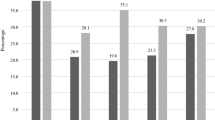Abstract
The relatively few studies conducted on fertility differentials in Ghana have not controlled for the effect of important demographic variables, such as age at first marriage and current age of respondent. This paper attempts a multivariate analysis of the relationship between cumulative fertility and age at first marriage, level of education, religion, form of marriage and residence of husband. Data drawn from a census sample survey in 1971 include 72,816 currently married females aged 15–49 years. Age at first marriage was inversely related to cumulative fertility. The differentials were more pronounced for older women. Among the older women, the differentials were larger for rural than urban women. There were also significant fertility differentials associated with level of education, religion and form of marriage. Husband’s residence was a poor predictor of cumulative fertility. As a policy measure, it is suggested that priority be given to providing young women with more education or employment opportunities as an alternative to early marriage.
Similar content being viewed by others
References
Andrews, F. M., J. N. Morgan, J. A. Sonquist and K. L. Klam. 1973. Multiple Classification Analysis. Ann Arbor, Mi.: University of Michigan.
Brass, W. 1975. Methods of Estimating Fertility and Mortality from Limited and Defective Data. Laboratories for Population Statistics. An Occasional Publication. Chapel Hill, NC.: University of North Carolina.
Census Office. 1971. 1960 Population Census of Ghana. Volume VI. The Post-Enumeration Survey (P.E.S.) Accra-Terna, Ghana: Ghana Publishing Corporation (Printing Division).
Ekanem, I. I. 1974. Influence of Polygamy on Fertility in Eastern Nigeria. Pp, 56–64 in B. Kwaku Adadevoh (ed.), Sub-Fertility and Infertility in Africa. Ibadan: Caxton Press (West Africa) Ltd.
Farooq, G. M. 1980. Household Fertility Decision-Making in Nigeria. Paper presented at the Annual Meetings of the Population Association of America, April 10–12, 1980, Denver, Colorado.
Gaisie, S. K. 1981. Child-Spacing Patterns and Fertility Differentials in Ghana. Pp. 237–253 in Hilary J. Page and Ron Lestaeghe (eds.), Child-Spacing in Tropical Africa: Traditions and Change. London: Academic Press Inc.
Republic of Ghana. 1969. Population Planning for National Progress and Prosperity. Ghana Population Policy. Accra-Tema, Ghana: Ghana Publishing Corporation (Printing Division).
World Fertility Survey. 1980. The Guyana Fertility Survey, 1975. A Summary of Findings No. 18. International Statistical Institute, Voorburg, The Hague, Netherlands.
Author information
Authors and Affiliations
Rights and permissions
About this article
Cite this article
Tawiah, E.O. Determinants Of Cumulative Fertility In Ghana. Demography 21, 1–8 (1984). https://doi.org/10.2307/2061022
Issue Date:
DOI: https://doi.org/10.2307/2061022




